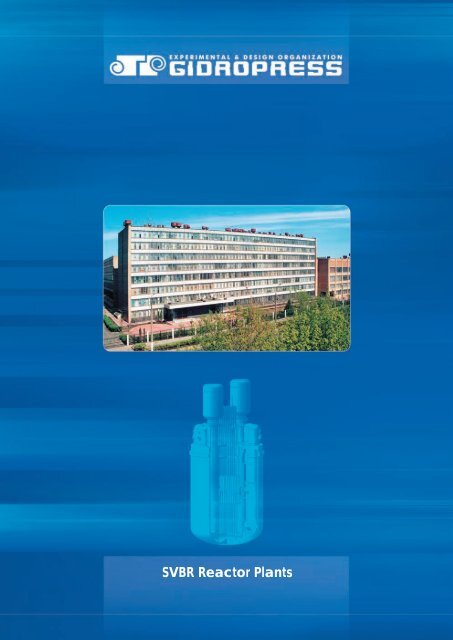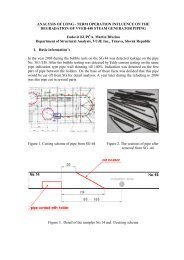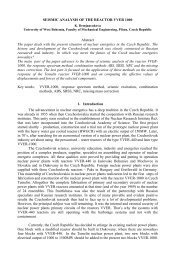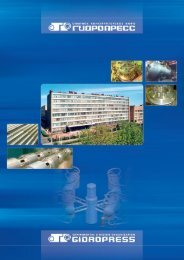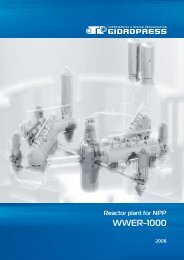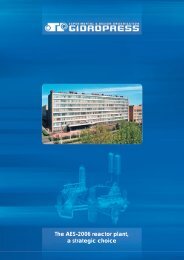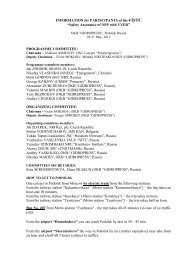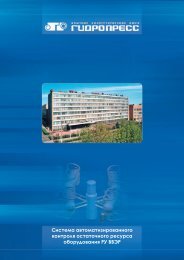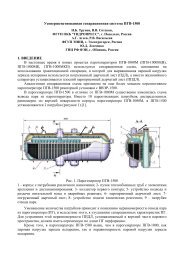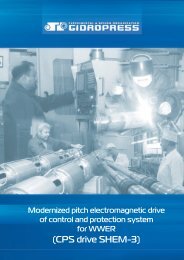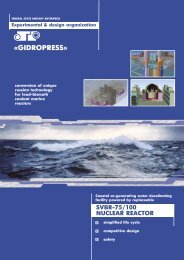SVBR Reactor Plants
SVBR Reactor Plants
SVBR Reactor Plants
Create successful ePaper yourself
Turn your PDF publications into a flip-book with our unique Google optimized e-Paper software.
<strong>SVBR</strong> <strong>Reactor</strong> <strong>Plants</strong>
<strong>SVBR</strong><br />
<strong>Reactor</strong> <strong>Plants</strong><br />
Innovative nuclear technology –<br />
no analogues in the world<br />
Engineering basis of <strong>SVBR</strong>-type reactors<br />
<strong>SVBR</strong>-type reactors were designed within the framework of the conversion of unique Russian technology for leadbismuth<br />
coolant marine reactors.<br />
World community shows still<br />
growing interest in nuclear<br />
power deeming it to be one of<br />
the main sources to meet the<br />
increasing need for power generation<br />
for the steady development<br />
of the mankind under the<br />
conditions of gradual depletion<br />
of nonrenewable sources<br />
of energy and environmental<br />
pollution.<br />
A search for reactor technologies that offer the prospect for XXI century is<br />
under way all over the world. The participants in GenIV Forum have chosen<br />
6 innovative reactor systems that incorporate lead-coolant systems, eutectic<br />
lead-bismuth alloy included that meet the Generation IV goals.<br />
Russia possesses unique experience in development and operation of<br />
lead-bismuth coolant submarine reactors.<br />
On the basis of lead-bismuth reactor technology EDO “Gidropress”, IPPE<br />
Russian Research centre and “Atomenergoproyekt” are developing the<br />
designs of small-power <strong>SVBR</strong> reactors (<strong>SVBR</strong> stands for the Russian acronym<br />
of lead-bismuth fast reactor) to create nuclear sources of power within the<br />
range from 6 MW-e to 100-400 MW-e, depending on the requirements of<br />
the Customer.<br />
Fig.1. Alfa nuclear submarine<br />
<strong>SVBR</strong> reactors provide:<br />
Two land prototypes and eight submarines reactor with lead-bismuth coolant have been constructed.<br />
Total operating time of the installations is about 80 reactor-years.<br />
ÔÔ A high level of inherent and passive safety<br />
ÔÔ Considerable simplification of the design of reactor and NPP as a whole in comparison<br />
with the traditional nuclear technologies<br />
A new nuclear power technology that has no analogues in the world was demonstrated on an industrial<br />
scale.<br />
ÔÔ A possibility to work with different kinds of nuclear fuels in different fuel cycles at their<br />
length for not less than 7 years<br />
<strong>SVBR</strong> reactor performance<br />
ÔÔ Technological support in meeting the non-proliferation requirements<br />
ÔÔ Conservative approach at designing. Orientation to the existing fabrication facilities<br />
and structural materials<br />
ÔÔ Small size and maximum in-shop availability of reactor<br />
ÔÔ Possibility of serial designing of NPP of different power and purpose as well as on-line<br />
methods in construction activities<br />
ÔÔ Competitiveness in the electricity market and NPP attractiveness for capital investments<br />
with a high potential for further improvement of technical and economic indices<br />
The selected power level for the installations, the physical properties of a fast reactor, natural properties of lead-bismuth<br />
coolant and integral design of the reactor make it possible to realize the inherent and passive safety properties<br />
to the utmost, assure meeting the increased requirements for the safety level of GenIV nuclear systems and the<br />
basic criteria of International Project on Innovative Nuclear <strong>Reactor</strong>s and Fuel Cycles.<br />
The combination of properties allows siting the power units with <strong>SVBR</strong>-type reactors close to population aggregates.<br />
At present <strong>SVBR</strong>-10 and <strong>SVBR</strong>-75/100 are the better developed reactor designs (so far conceptual designs have<br />
been worked out).<br />
Main performance of <strong>SVBR</strong>-10 and <strong>SVBR</strong>-75/100<br />
Parameter <strong>SVBR</strong>-10 <strong>SVBR</strong>-75/100<br />
<strong>Reactor</strong> thermal power, MW 43,3 280<br />
Functional diversity and area of application<br />
<strong>Reactor</strong> electric power (gross), MW 12 101,5<br />
Generated steam pressure, MPa 4,2 * 9,5**<br />
Lead-bismuth coolant temperature, inlet/outlet, °С 320 / 480 320 / 482<br />
Power units of a wide power spectrum can be constructed based on the <strong>SVBR</strong>-type reactor using the<br />
modularity principle to be applied in:<br />
ÔÔ<br />
electric and thermal power generation;<br />
Fuel:<br />
type<br />
average enrichment in U-235,%<br />
UО 2<br />
18,7<br />
UО 2<br />
16,5<br />
Core fuel cycle, thousand, eff.hours 135 53<br />
Time between refuelings, years 15-20 7-8<br />
2<br />
ÔÔ<br />
ÔÔ<br />
sea water desalination;<br />
powered process complexes (for example, coal-chemical, metallurgical and gas-chemical complexes).<br />
* – superheated-410ºC<br />
** – saturated - 307ºC or superheated - 400ºC<br />
3
<strong>SVBR</strong><br />
<strong>Reactor</strong> <strong>Plants</strong><br />
<strong>SVBR</strong>-75/100 -<br />
simple design and increased<br />
safety<br />
<strong>SVBR</strong>-75/100 reactor meets the most stringent safety requirements (it is human error proof, fail-safe,<br />
proof against sabotage and other ill-intentioned human actions) due to reactor inherent safety resulting<br />
from a combination of reactor type, primary coolant properties and reactor design:<br />
ÔÔ Very high temperature of<br />
lead-bismuth coolant boiling<br />
(~1670ºC) eliminates accidents<br />
due to DNB in the core<br />
and makes it possible to maintain<br />
low primary pressure under<br />
normal operating conditions<br />
and in case of hypothetical accidents;<br />
ÔÔ All primary equipment (Fig. 2)<br />
is housed inside a strong vessel<br />
with a protective housing to<br />
provide an integral (single-unit)<br />
layout. Small free space between<br />
the main vessel and protective<br />
housing prevents loss<br />
of coolant in case the integrity<br />
of reactor main vessel is lost (a<br />
postulated accident);<br />
ÔÔ The level of natural circulation<br />
of the primary and secondary<br />
coolant is sufficient for passive<br />
heat removal under cooldown<br />
conditions;<br />
ÔÔ The cartridge core is located<br />
inside a tank filled with water.<br />
Passive heat transfer via vessel<br />
to the tank water provides passive<br />
cartridge core cooldown<br />
in case all active heat removal<br />
systems fail (a postulated combination<br />
of a number of initiating<br />
events) within at least 5 days<br />
of human non-intervention;<br />
ÔÔ Favorable neutron-physical<br />
properties of lead-bismuth<br />
coolant, a low coefficient of<br />
volumetric expansion in a<br />
combination with the control<br />
algorithms provide an operative<br />
reactivity margin below<br />
1β eff<br />
within the entire fuel cycle,<br />
which in principle excludes a<br />
possibility of reactivity-induced<br />
accidents with prompt neutron<br />
runaway;<br />
ÔÔ Negative reactivity feedbacks<br />
provide power reduction to<br />
the level that does not lead to<br />
core damage in case of an uncontrolled<br />
withdrawal of RCCA<br />
in case of a failure of the highest<br />
worth rod of reactor trip system;<br />
ÔÔ A possibility of chemical explosions<br />
and fires due to internal<br />
causes is ruled out thanks to inherent<br />
safety as the lead-bismuth<br />
coolant remains chemically<br />
inert in case of a loss<br />
of circuit integrity and possible<br />
contact with water and<br />
air. The capability of lead-bismuth<br />
coolant to retain fission<br />
products (iodine, caesium, actinides<br />
- except for inert gases)<br />
can considerably mitigate the<br />
radiological consequences of<br />
a postulated loss-of-coolant<br />
accident;<br />
ÔÔ No materials are applied in<br />
reactor that could evolve hydrogen<br />
either under normal<br />
operating conditions or in accidents;<br />
ÔÔ The assumed primary-to-secondary<br />
pressure ratio, its value<br />
being permanently higher in<br />
the secondary circuit, eliminates<br />
the possibility of radioactive<br />
contamination of steam<br />
to be generated by the system<br />
not only under normal operating<br />
conditions but also in case<br />
of primary-to-secondary leaks<br />
in the SG tubing system;<br />
ÔÔ Low potential energy accumulated<br />
in the primary circuit (low<br />
primary pressure) only restricts<br />
the scale of possible reactor<br />
damage by external impacts.<br />
Protection against external impacts<br />
is ensured by placing the<br />
reactor inside a tight concrete<br />
compartment (Fig. 3);<br />
ÔÔ Due to high safety inherent<br />
to <strong>SVBR</strong>-75/100 reactor, even<br />
a postulated combination of<br />
such initiating events as concrete<br />
compartment destruction<br />
and a large break of primary<br />
gas system followed by<br />
a direct contact of lead-bismuth<br />
coolant surface with atmospheric<br />
air, does not bring<br />
about reactor runaway, explosion<br />
and fire. Possible radioactive<br />
release is predicted to be<br />
below the level that might require<br />
evacuation of the local<br />
population<br />
Fig. 3.<br />
Layout of reactor equipment<br />
inside a concrete compartment<br />
Modular principle of construction for <strong>SVBR</strong>-75/100-based NPPs considers the need for a smaller-scale<br />
sources of power for a wide spectrum of potential customers<br />
The modular principle in NPP construction<br />
when a NSSS of a power<br />
Unit is made up of a few <strong>SVBR</strong>-<br />
75/100 reactor modules jointly operating<br />
for one or several turboplants<br />
makes it possible to construct NPPs<br />
of various power scales depending<br />
on the needs of the customer and<br />
their business solvency (Fig. 4).<br />
<strong>SVBR</strong>-75/100<br />
4<br />
Fig. 2. Cartridge core reactor<br />
Fig. 4.<br />
Modular NPP with four <strong>SVBR</strong>-75/100<br />
reactors<br />
5
<strong>SVBR</strong><br />
<strong>Reactor</strong> <strong>Plants</strong><br />
Area of possible application for<br />
<strong>SVBR</strong>-75/100<br />
Nuclear powered water-desalinating facility (NPWDF)<br />
On the basis of standard <strong>SVBR</strong>-75/100 reactors different-purpose power Units can be constructed. They<br />
can be applied as a part of:<br />
ÔÔ<br />
local different-purpose power sources of different power scale sited in the centers of power consumption;<br />
ÔÔ floating or coastal NPPs to generate electric and thermal power and desalination of sea water both in Russia<br />
and abroad on the basis of the principle: Construction – Ownership – Leasing (or operation). The services can<br />
be rendered to developing nations with the non-proliferation principle considered;<br />
ÔÔ besides, these reactors can be used for renovation to replace the decommissioned power units after their extended<br />
service life has expired. Such a renovation will permit to keep the viability of the NPP satellite towns as<br />
well as the grid, transportation and water infrastructure integrating into the NPP life cycle until the service life of<br />
long-time structures expires.<br />
Layout of co-generating nuclear-powered water desalinating facility:<br />
ÔÔ<br />
ÔÔ<br />
permanent coastal power-generating facility;<br />
replaceable secure transportable autonomous reactor (STAR).<br />
The main design organizations<br />
of the conceptual design<br />
for the NPWDF are:<br />
ÔÔ EDO “GIDROPRESS”,<br />
ÔÔ Russian Research Centre<br />
IPPE,<br />
ÔÔ SPbAEP,<br />
ÔÔ SPMBM «Malakhit»,<br />
ÔÔ Central Research Institute<br />
named after A.N.Krylov.<br />
Local co-generating NPP of average power<br />
6<br />
Rosatom enterprises EDO “Gidropress”,<br />
Russian Research Centre<br />
IPPE, SPbAEP, SPMBM «Malakhit»,<br />
Central Research Institute named<br />
after A.N.Krylov have developed<br />
a conceptual proposal on local<br />
co-generating NPP made up of 4<br />
<strong>SVBR</strong>-75/100 reactors (Fig. 5). The<br />
prominent features of inherent and<br />
passive safety as well as a relatively<br />
low level of <strong>SVBR</strong>-75/100 unit power<br />
allow siting the co-generating NPPs<br />
in the vicinity of centers of populations<br />
(at the town development<br />
boundary). At this, the expenditure<br />
on heat transport to the users considerably<br />
decreases.<br />
Technical-economic indices for co-generating NPP<br />
with 4 <strong>SVBR</strong>-75/100 reactors (in roubles, as of 1991).<br />
Parameter<br />
Co-generating NPP power<br />
- electric, max., MW<br />
- electric, nominal, MW<br />
- heat generation capacity, Gcal/h<br />
Capital investments, thousand rbl.,<br />
Including investments for production of:<br />
- electricity<br />
- thermal power<br />
Specific investments for production of:<br />
- electricity, rbl/kW<br />
- thermal power, thousand rbl/Gcal/h<br />
Net cost of sold-off:<br />
- electricity, kopecks /kW.h<br />
- thermal power, rbl/Gcal<br />
Investment pay-back period<br />
- undiscounted, years<br />
- discounted, years<br />
Value<br />
406<br />
380<br />
520<br />
466 590,82<br />
326 613,57<br />
139 977,25<br />
859,5<br />
269,0<br />
1,35<br />
6,43<br />
8,5<br />
17,5<br />
Fig. 5. Local co-generating NPP<br />
with <strong>SVBR</strong>-75/100 (general view)<br />
Fig. 6. Co-Generating Nuclear-Powered Water Desalinating Facility based<br />
on <strong>SVBR</strong>-75/100 STAR:<br />
1 – secure transportable autonomous reactor (STAR); 2 – protective dry dock; 3 – building<br />
for steam-turbine plant; 4 – building for desalinating plant pumps; 5 – desalinating<br />
plant modules; 6 – desalinated water storage tanks; 7 – reactor cooling site for coolant<br />
solidification before transportation; 8 – office building.<br />
Fig. 7. <strong>SVBR</strong>-75/100 secure transportable autonomous reactor (STAR)<br />
Performance of Co-Generating Nuclear-Powered<br />
Water Desalinating Facility<br />
Parameter<br />
Service life of STAR between refuelings, years 8<br />
Value<br />
Maximum output of fresh water, thousand m 3 /day 200<br />
Electric power of nuclear-powered water desalinating facility<br />
with TG operating in the mode of condensing, MW<br />
80<br />
Power output into grid at maximum fresh water output, MW 9,5<br />
A nuclear powered water desalinating<br />
facility consists of two types<br />
of plants: distillation water-desalinating<br />
plant (DDP) of multi-stage<br />
evaporation and reverse osmosis<br />
water-desalinating plant (RODP).<br />
Installed power of water-desalinating<br />
plants of both types is the same<br />
and amounts to 50 % of the desalinating<br />
facility installed power<br />
which is 100 000 m3/day. Salt content<br />
in DDP desalinated water is 20<br />
mg/l, salt content of RODP desalinated<br />
water is 200 mg/l.<br />
Secure transportable autonomous<br />
reactor (STAR) (Fig. 7) resembles a<br />
replaceable “nuclear storage battery”.<br />
The STAR is supplied based on<br />
the principle: Construction – Ownership<br />
– Leasing for a period determined<br />
by reactor core cycle (at<br />
least 8 years). Supplier runs all the<br />
financial and radiation risks of STAR<br />
construction, transportation, operation<br />
and probable accidents.<br />
7
<strong>SVBR</strong><br />
<strong>Reactor</strong> <strong>Plants</strong><br />
Economic indices of NPWDF<br />
For the Customer the cost of construction and operation of nuclear-powered water desalinating facility<br />
amounts to:<br />
ÔÔ capital costs ~ 260 M$, including:<br />
- coastal structures– 60 M$;<br />
- DDP equipment – 120 М$;<br />
- RODP equipment – 80 M$;<br />
ÔÔ annual costs ~ 30 M$/year, including:<br />
- rent for the STAR with account for shipment ~ 12 M$/year;<br />
- cost of NPWDF operation and services ~ 18 M$/year.<br />
The term of NPWDF recoupment and the crediting rate are determined by the Utility for a specific facility<br />
site depending on the local tariffs for fresh water. The accepted rent for the STAR of 12 M$/year will<br />
make it possible:<br />
ÔÔ<br />
ÔÔ<br />
LWR NPP renovation after reactor<br />
service life had expired<br />
Estimated cost of STAR<br />
construction for the Supplier<br />
will be ~ $ 44 million including<br />
the cost of the first fuel<br />
cycle.<br />
for the Supplier to attract investments for STAR construction on the basis of a commercial credit;<br />
3<br />
for the Utility to provide competitive price of the products produced (for example, fresh water ~ 1 $/m and electric<br />
energy ~ 0,035 $/kW*h) and commercial attractiveness of the project (for example, the period of project recoupment<br />
is ~12 years at ~ 10% crediting rate for the loaned capital.<br />
Renovation of NPP Units with light-water reactors after reactor service life has expired is realized by siting the required<br />
number of <strong>SVBR</strong> 75/100 reactors in the emptied compartments that used to house steam generators and reactor<br />
coolant pumps to create a modular structure of the renovated unit.<br />
<strong>SVBR</strong>-10 – reactor with<br />
super-long fuel cycle for<br />
local power supply<br />
On the basis of <strong>SVBR</strong>-10 reactors power units of various purpose and<br />
power range can be constructed without on-site refueling in coastsited,<br />
floating and land-based embodiments.<br />
These power units can be used to generate electric and thermal<br />
energy, sea water desalination etc.<br />
The main organizations to<br />
develop <strong>SVBR</strong>-10 reactor<br />
conceptual design are:<br />
ÔÔ EDO “Gidropress”,<br />
ÔÔ Russian Research Centre<br />
IPPE.<br />
Small transportable autonomous reactors for small-power<br />
coastal NPPs<br />
The concept of costal small-power NPPs was developed in 2005 that incorporate coastal structures and replaceable<br />
STARs with <strong>SVBR</strong>-10 to be delivered to the NPP site and taken back to the Supplier country by sea for core<br />
refueling (Fig. 9).<br />
Fig. 9. Coastal small-power NPP<br />
based on <strong>SVBR</strong>-10 STAR<br />
8<br />
Fig. 8. Renovation diagram for a NPP with a light water reactor<br />
The results of technical and economic feasibility studies for NV NPP Units 2, 3 and 4 renovation on the basis of <strong>SVBR</strong>-<br />
75 have shown that the construction of new power Units to replace the decommissioned ones is twice as expensive<br />
as the renovation as far as the specific investments are concerned.<br />
STAR (Fig. 10) is 8 m in diameter and 11,2 m high, its weight being 310 t with<br />
coolant. Cartridge reactor (without the core) is completely fabricated at<br />
the manufacturing plant.<br />
The coast-sited NPP is a preferable option for the Customer that has already<br />
developed industrial or social infrastructure or intends to develop it. Otherwise,<br />
the floating-type NPP will be a better option for the Customer.<br />
Fig. 10. <strong>SVBR</strong>-10 secure transportable<br />
autonomous reactor<br />
9
<strong>SVBR</strong><br />
<strong>Reactor</strong> <strong>Plants</strong><br />
Floating NPP with two <strong>SVBR</strong>-10 reactors<br />
Conceptual design of a floating-type NPP with two <strong>SVBR</strong>-10 (Fig. 11) reactors was developed by JSC “Atomenergo”<br />
and reactor design organizations. The results of design development state that a possibility exists to create a power<br />
source that possesses a higher safety level and a better economic efficiency in comparison with a floating NPP with<br />
water-cooled and water-moderated reactors.<br />
Avenues of further development<br />
<strong>SVBR</strong>-type reactor designs are aimed at providing operation with different types of fuel and in different fuel cycles<br />
that most correspond to each stage of nuclear power engineering development without changing the construction<br />
or safety characteristics deterioration. At the first stage the usage of proven uranium oxide fuel and operation<br />
in an open fuel cycle with a delayed recycling is offered. In a closed fuel cycle with MOX-fuel applied, the reactor<br />
will operate in the mode of fuel regeneration. When nitride fuel is applied fuel breeding will be provided. Spent fuel<br />
from VVER and RBMK reactors can be directly used as the make-up fuel without separating uranium, fission products,<br />
plutonium and minor actinides.<br />
After appropriate experimental study has been performed, an increase in reactor parameters and, consequently,<br />
unit power is possible.<br />
Status of work in lead-bismuth reactor<br />
technology<br />
Fig. 11. Floating NPP with two <strong>SVBR</strong>-10 reactors<br />
The application of a fast reactor lets decreasing the amount of cartridge cores used within the period<br />
of operation and refrain from on-site refuelings which permits to eliminate additional refueling facilities<br />
and fresh and spent fuel storage structures in the design of the floating NPP.<br />
Besides, the well-developed inherent and passive safety features lead to simplification of the NPP reactor and subsequently,<br />
to a reduction in the amount of its systems and equipment.<br />
Project economic efficiency<br />
To estimate the economic efficiency<br />
of the designed floating<br />
NPP the Central power park of the<br />
Kamchatka Region was chosen to<br />
be the area of its siting. The selling<br />
rates for heating and electricity<br />
are accepted corresponding to<br />
the average tariffs in the Central<br />
power park as of 01.01.2006.<br />
Integral efficiency indices for floating NPP with <strong>SVBR</strong>-10 reactor<br />
Index<br />
<strong>SVBR</strong>-10<br />
The economic efficiency of the floating NPP construction project was calculated in accordance with the methodological<br />
recommendations approved by the Ministry for Economics and Gosstroy of Russia.<br />
Floating NPP installed power, MW-e 24<br />
Simple recoupment period, years 10<br />
Discounted recoupment period (d=8%), years 16<br />
Value<br />
Internal return on assets 10,5%<br />
Profitability index 1,23<br />
The calculations assumed Project financing by bank crediting at 8 % annual rate in currency. The credits are loaned<br />
in three tranches with a 4-year term of each tranche payback. The calculations show that the payables will be paid<br />
off 8 years after the first tranche has been transferred.<br />
The results of the work in the given direction were considered<br />
at the meeting of the Scientific and Technical Council<br />
of Rosatom of Russia and the decision reads:<br />
“The scope and extension of <strong>SVBR</strong>-75/100 design development,<br />
maximum possible usage of proven engineering decisions, available<br />
structural materials and fuel infrastructure and the capacities<br />
of the machine-building industry as well as the available<br />
achievement in research and development to substantiate the<br />
lead-bismuth technology lead to a conclusion that the reactor<br />
technology can be realized in a pilot power plant project to prove<br />
the possibility and efficiency of the promising application of the<br />
technology”.<br />
It was found expedient to go on designing a prototype power unit<br />
with <strong>SVBR</strong>-75/100 reactor for a selected site.<br />
The task to construct the prototype power unit with <strong>SVBR</strong>-75/100<br />
reactor is part of the Federal Target Programme “Development of<br />
nuclear power complex of Russia in 2007-2010 and directions up<br />
to 2015”. At present the development of detailed project report is<br />
under way.<br />
<strong>SVBR</strong>-75/100 project was the<br />
winner at the Innovation Forum<br />
II of Rosatom in 2007 in the<br />
nomination “Nuclear power industry”.<br />
The calculations show that with the average selling rate of thermal energy of 40 $/Gcal, the minimum (boundary)<br />
selling tariff for electricity will be 4,8 cents/kW-h. Specific process costs (tax-free) will amount to 1,5 cents/kW-h with<br />
account for the kilowatt-hours in the form of heat supplied to consumers.<br />
10<br />
Processability indices<br />
All equipment for the <strong>SVBR</strong> reactor-based power Units can be manufactured at the machine-building plants of the<br />
Russian Federation. Since no unique machine-building equipment is required to manufacture the reactor (in comparison<br />
with vessels for water-cooled and water-moderated power reactors), a possibility for competitive manufacturing<br />
arises. Advanced methods of serial designing and on-line methods in construction activities can be used at<br />
modular-type power units construction which considerably shortens the terms and cost of work performance.<br />
11
21, Ordzhonikidze Street, 142103 Podolsk,<br />
Moscow region, Russian Federation<br />
Tel.: (495) 502-79-10, (4967) 54-25-16<br />
Fax: (495) 715-97-83, (4967) 54-27-33<br />
Http://www.gidropress.podolsk.ru | Email: grpress@grpress.podolsk.ru


